Interesting ideas and innovations in the world of water.
Don't wanna be here? Send us removal request.
Text
The Story of Ayyeka
By: Michelle Nadboy
February 16, 2016
The inspiration for Ayyeka began about seven years ago when two friends, Ariel Stern and Yair Poleg, decided to spend their free time in a dusty old garage developing a new technology. The two engineers sat huddled next to space heaters trying to invent a revolutionary product, eventually resulting in the founding of Ayyeka.
Each of them grew up living and breathing technology but took slightly different paths during their army service. Yair began programming as a teenager and post high school was drafted into the Israeli army to work in the elite 8200 intelligence unit. For him, the 8200 unit was like a dream: he had access to some of the most advanced military-grade technologies available. He worked in the cyber-security team, which is why he made sure Ayyeka’s technology is cyber-secure. After completing a B.A. in Computer Science, he went on to Hebrew University to complete a Ph.D. in computer vision, the technology used to develop self-driving cars. As Ayyeka’s CTO, he now invests a lot of time and energy working with customers on systems integration, securing the company’s IP portfolio, and finding new ways to develop the most cutting edge cyber-security features.
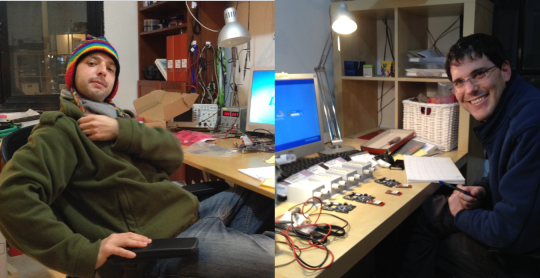
Yair and Ariel working in the garage in 2011.
Ariel decided to pursue his B.A. in electrical engineering at the Technion, through the Israeli Airforce’s Academic Reserve program, and reached the level of captain. The Airforce was like his own engineering playground. He worked with the coolest toys like the F16 fighter aircraft, where he even built a new aircraft subcomponent using scraps of equipment, saving the unit time and money. He also served as a project manager for a top-secret Ministry of Defense project. Throughout their army service, Ariel and Yair continued to cross paths and planned to partner and launch their own company. As Ayyeka’s CEO, he travels frequently, working directly with customers and generating new business opportunities. “Ayyeka started as a garage project and eventually became a reality,” Ariel says.
What was the inspiration for the name Ayyeka? Yair told Ariel that his bike was stolen at the Tel Aviv train station. The two engineers decided someone needed to create a GPS tracking device that could be installed inside the bike, hidden from potential thieves. After many hours of testing and re-testing, their new device was finally complete. It came time present the bike tracker at an important meeting, which also meant ordering business cards.
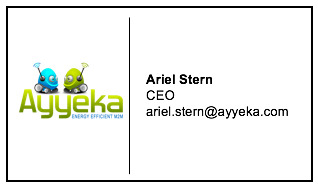
Ayyeka’s original business cards displaying the old logo.
A company name meant business. The two friends came up with the name Ayyeka. Literally translated from Hebrew, Ayyeka means, “Where are you?” Ayyeka comes from the famous bible story when Adam and Eve ate the forbidden fruit and hid from god. God called out to them, saying, “Where are you?” Biblical commentators go a step further, explaining that the term Ayyeka does not only mean where is your location, but also why aren’t you here? This biblical reference perfectly described their new bike tracking device.
After the 2008 market crash, the co-founders quickly realized that the bicycle device would not lead to a promising business opportunity and began seeking another use for the technology. Ariel’s family friend, a water engineer, asked if the device could collect data from local water infrastructure. They connected a sensor to the device to measure flow data, and sold the first five devices to an Israeli water utility.
“Some of my friends started companies way before we started thinking about Ayyeka. But, while we were working in the garage the perfect storm developed,” Yair says. The Internet of Things (IoT) market had already started creating a buzz and the Wavelet water monitoring device was a perfect IoT solution for the water industry.
The water industry is generally conservative and somewhat connected; utilities cannot monitor vital quality and quantity information in real-time. Industry leaders know that data is needed to better manage infrastructure and are looking for innovative solutions to connect aging infrastructure to control centers. On the other hand, “Humans are fully connected,” Ariel notes. “We use Fitbits and Apple watches to monitor our every move, which is exciting but not essential. It proves that the technology exists and can also be used to create an industrial transformation.” Industrial networks need to establish connectivity and at the same time address the challenges of aging infrastructure and a growing population. Connected autonomous devices, like the Wavelet, bridge the industrial data gap. Ayyeka is helping to transform the conservative water industry through the creation of plug-and-play cost-effective smart networks.
Even though Ayyeka is now established as a leader in remote water monitoring, these two engineers know that the technology can become even smarter. Ariel and Yair want to enter new market segments, test new smart city applications, and transform our understanding of public infrastructure investments. “Who knows where we will be in five years,” Ariel says. Stay tuned.
1 note
·
View note
Text
IoT: Implications for Human Nature and the Environment
By: Tal Avrahami
December 17, 2015
As Ayyeka’s Business Development Manager, I had the pleasure of representing our company in a recent panel discussion at IDC Herzliya: “Startup Companies in the Environment and Internet of Thing (IoT) Space,” which was moderated by Dr. Oren Zuckerman, Director of the Media Innovation Lab. The topics of the discussion included: the conflict between human disposition toward intuition and improvisation on the one hand and data and analytics on the other, the magnitude of change that IoT can deliver, and technological solutions to the world’s most pressing environmental challenges. Below are some takeaways from the panel discussion.
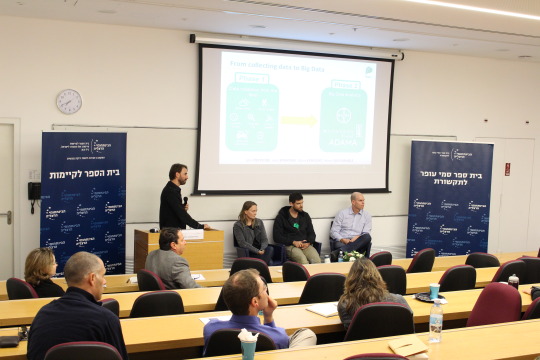
Data collection is the jumping-off point for many of the biggest leaps in technological advancement across sectors such as manufacturing, energy, aerospace, logistics, healthcare, or even cartography. For example, the core of transformative technologies like Google Maps and Google Earth is vast quantities of data that is collected, organized and analyzed. However, there is still a tension that exists between human nature and data. A plant manager at a centralized water treatment facility can measure the quality of the water that is being pumped into the distribution network. But if you show the same plant manager remote data collected by smart sensors in the distribution network that the water quality is actually quite different from the water that left the centralized facility, the question becomes whether they are willing to trust the data or stand by their intuition that it should not differ. Are you willing to believe the heart rate measurement of your wearable device? By the same token, are you willing to believe the “pulse” (i.e. pressure, flow, quality) of your water infrastructure network?
IoT can bring transformative change to the water and other industrial sectors. Remote data is a pre-requisite for establishing key performance indicators (KPIs), ensuring regulatory compliance, and achieving real-time situational awareness of the infrastructure network and environment. Industrial automation can vastly improve environmental, resource and infrastructure management; bring down operational costs; and improve customer experience and satisfaction. However, the effectiveness of industrial automation systems depends on feeding them large volumes of high-quality data. The premise of Ayyeka’s remote monitoring solutions is to streamline and secure the process of brining field data to decision makers, analytics platforms, and SCADA systems that are fundamental to industrial automation.
The world confronts numerous, inter-connected environmental challenges, chief among them climate change, water scarcity, food security, resource depletion, and ecosystem collapse. There is no “silver bullet” to address these challenges, but devising solutions requires a constant stream of data. By collecting remote data, one can establish baseline measurements, assess the current status of the system, develop strategies for improved management, establish investment priorities, take action, and measure results. Remote monitoring in conjunction with industrial automation increases the speed of this cycle.
2 notes
·
View notes
Text
Smart Infrastructure Systems Tempt Cyber Attackers
By: Mickey Chesla
November 2, 2015
Our water, energy and other critical infrastructure systems are becoming smarter, more sophisticated and more digitized. Unfortunately, this also makes them more vulnerable to more frequent and sophisticated cyber threats. Ayyeka’s CTO Yair Poleg explains how infrastructure can be protected in this brave new world.

The battles of the future will be fought, at least partially, in the cyber arena. Critical water and energy infrastructure are the ultimate targets for cyber attackers. Unfortunately, we are poorly positioned at present to prevent them.
We may not hear about them in the general news news every day, but the number of cyber attacks on critical infrastructure is growing. According to PricewaterhouseCoopers' 2015 report on cyber security, "the number of reported security incidents rose 48 percent this year to 42.8 million – which is the equivalent of 117,339 attacks per day." Governments may prefer to limit coverage of such attacks to prevent fear among the general public, but there is no question attacks are on the rise.
Why is this the case? Systems are becoming more digitized and more advanced, making them more efficient, but also more vulnerable to cyber attacks. As Michael Assante wrote in Forbes: “America’s critical infrastructure—the utilities, refineries, military defense systems, water treatment plants and other facilities on which we depend every day—has become its soft underbelly, the place where we are now most vulnerable to attack.”
Yair Poleg, CTO of Ayyeka, a provider of remote monitoring kits for smart infrastructure networks, explains more in depth why this is the case: “Infrastructure companies are increasingly depending on remote monitoring. They are protecting their centers – or to use professional jargon, Supervisory Control and Data Acquisition (SCADA) systems – but it is simply impossible to provide physical protection for the multitide of systems in the field. So really, any feeling of security that comes with protecting only the SCADA systems is not complete without protection of the endpoints.”
One step towards improving the protection of critical infrastructure is more stringent government regulation, and this trend is indeed unfolding, according to Poleg. But most infrastructure companies need to place cyber security at the top of their list of priorities.
Ayyeka has already taken this step. The company’s founding team emerged from 8200, the elite cyber defense unit in the Israel Defense Forces (IDF) that has bred some of the world’s most advanced cyber security technologies. “In Israel, cyber protection is fundamental,” explains Poleg. “We placed cyber security as a top priority in our solutions from day one.”
The company’s patent pending remote monitoring kits provide systems that are inherently secure. “Since it is impossible to physically fence in hundreds or thousands of remote monitoring sites in a network, the only real solution is to choose a solution that provides inherent cyber protection,” concludes Poleg.
1 note
·
View note
Text
Where Can We Get the Water? Breaking Down California’s Crisis
By: Mickey Chesla
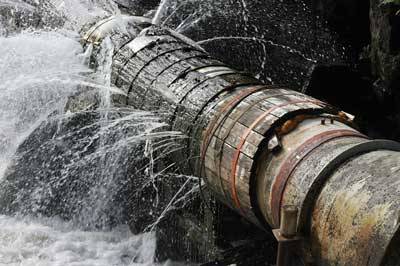
California’s water shortage crisis is being discussed and addressed on a number of fronts. Before bringing solutions, it’s important to understand where lays the greatest potential for bringing more available water into California’s water systems.
“There are basically two options to create more water availability – increase supply, or reduce demand,” explains Ayyeka’s VP Business Development, Sivan Cohen. The first option, increasing water supply, can be done through bringing in additional water, desalination or reducing water loss along the conveyance system. Overall supply is limited, and there are downsides to desalination which include the costly and lengthy process of building desalination plants. They are also very costly to operate and maintain, and if the demand for desalinated water drops, the initial investment may not be reimbursed. Add to this the environmental impact, and it is clear that desalination should not necessarily be the first option considered.
There is a lot already being done on the front of altering demand for water, particularly on the residential consumer front. Evem with raising awareness, installing water efficient appliances in homes, offering government incentive programs, and so on, the potential for water savings on the residential demand sideare actually quite limited. “Only 14% of the water supply goes to residential consumers, with the vast majority, 80% going to agricultural use, and 6% to industry,” explains Cohen. “Even if the statewide goal of lowering residential demand by 25% is achieved, this still only means a 3.5% increase in the overall water supply.” Which brings us to the third major stop on the side of water supply – Non-Revenue Water, or NRW. NRW is the water that is “lost” from the minute it enters the utility’s pipes to the point at which it reaches the consumer. The causes for this loss are both physical losses (water leaks) and what is called “apparent losses” – water that is lost through theft or inaccurate measurement. But NRW is often a “mystery.” Even the definition of NRW is not always clear, with some including stolen water in the equation, while others do not.
So how much water is really lost in the California water systems, and how can we minimize the loss? “The truth is we don’t know the level of California’s NRW,” says Cohen. Data collection and reporting from the field as to NRW is partial at best, as a recent UCLA study detailed. “But we can make some safe estimates. The world’s most advanced countries in water measurement and management, Israel and Australia, report around 10-15% NRW. Water experts target 10% as the lowest realistically achievable level.” The world average is around 30%, with underdeveloped nations, such as some African nations, showing even 80-90% loss. So most likely California is in the realm of the international average, or around 20-40% loss.concludes Ariel Stern, CEO of Ayyeka.
Assuming for the sake of argument a 20% NRW for California – if through improvement measurement and management we could cut that in half we would save 10% of the state’s water supply. Compare that to the 3.5% total savings that Calfornia is striving to achieve through lessening demand, (it’s about 3 times as much.
So how can we lower NRW? The key is to addressing NRW is measurement, and this is where Ayyeka comes in. The company’s remote monitoring kits make monitoring simple, secure and affordable. According to Stern, the company’s solution is already in use in Israel to determine the amounts of water supplied to municipal areas. “Setting up district metering areas (DMAs) with flow meters to monitor the inflow to the zoned area, enables data collection about the supplied water and enables the creation of a unified, credible and continuous database of information on which to base NRW calculations,” says Stern.
In California too, effective measurement requires dividing up the large and complex water systems into distinct DMAs. Regulation will need to be implemented to ensure utilities provide accurate, reliable data on their NRW. Senate Bill 555, introduced by state Senator Lois Wolk (D-3rd District), would require this.
“California doesn’t have time to waste,” concludes Cohen. “The state needs to increase its available water, quickly. The fastest, most effective way to do this is to lower NRW, and data collection is the key first step.”
1 note
·
View note
Text
Overcoming the Water Measurement Hurdle in California
By: Mickey Chesla
“If you can measure it, you can manage it.” If this statement sinks in and starts being implemented in California, that would go a long way to solving the dramatic water shortage the state is facing. This is also the driving vision behind Ayyeka’s water measurement solution. When Ayyeka’s Director of Business Development, Sivan Cohen, P.E., was living in California, she had no idea how much she paid for water, and her water usage had no influence on her monthly bill. “Where I lived water was included in the rent, no matter how much water I used. Only when I moved to Israel did I get my first water bill in the mail. It was a pretty big bill, and created an incentive for me to think twice before I left the faucet running or took a long shower.”
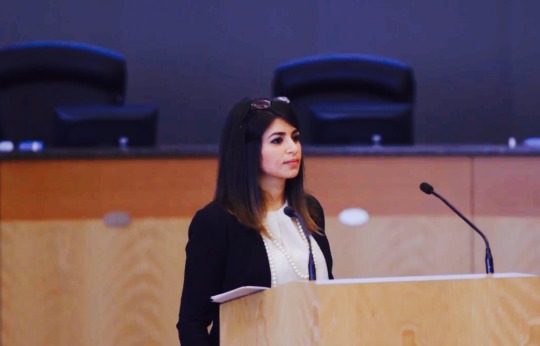
Ayyeka's Director of Business Development, Sivan Cohen, P.E., speaking at Sacramento City Hall in talk titled "If You Can Measure It, You Can Manage It."
Unlike in Israel, where from day one water is government property, owned, measured and billed by the state, the U.S. water market is a whole different story. There are hundreds of water utilities in California alone, each with its own rules and methods, making implementing change a major challenge.
As California begins to tackle the issue, it’s finding that gathering measurement data is the important first step, and a challenging one. Stephanie Pincetl, the director of UCLA's California Center for Sustainable Communities, was recently quoted in the Los Angeles Times, saying: "I think we have a really big problem in California in that water agencies do not report water data in any kind of regular and granular level," she said. "We really don't know how much water is used by whom in the state. We can debate about methodology, but unless you have really reported data, it's difficult to know."
Ayyeka’s solution makes the measurement pill a little ‘easier to swallow’ for water utilities. The company’s remote monitoring kits make monitoring simple, secure and affordable. Extending smart water networks with the remote monitoring systems allows for improved network visibility, reduced operating costs, enforcement of regulation compliance, faster leak detection, more exact billing and other advantages, which ultimately mean savings of water and money.
The kits are being installed in utilities in Las Vegas, Cincinnati and Italy. Ariel Stern, the company’s CEO, recently presented the solution to leading figures from California’s water industry at the California-Israel Global Innovation Project of the Milken Innovation Center in Jerusalem. Representatives from Governor Jerry Brown’s office were impressed with the solution and technology. The company is partnering with sensor provider Turner Designs in the California market, and working through its joint venture group, the Noria Ayyeka Group.
Despite Governor Brown’s emergency drought declaration initiative in January, and calling for a 25% reduction in water use, statewide water use has actually increased by 1%, according to the LA Times. “Before running out to plan another desalination plant, which guzzles environmental resources and is a huge expense, California would do well to better manage the water it does have, and measurement is the important first step in this process,” concludes Cohen.
For more information on Ayyeka’s solution click here.
0 notes
Text
Well, Hello.

We here at Ayyeka are starting our own blog to share what we find fascinating in the world of water.
Who is Ayyeka, you ask? We are a start-up team of engineers in Israel using our expertise in civil, electrical, and computer engineering to create smart water products.
Why water? Well, for one, water is the most used substance on the planet (with concrete coming in at second place). Water is also going to be one of the scarcest resources in the near to mid-distant future, and so we need to figure out how to use the resources that we currently have in an efficient and environmentally responsible manner. And, to boot, the water industry is one of the oldest (think Roman aqueducts) and most segregated industries, and it occurred to us that we would like to be a part of bringing it up to speed and bridging the gaps.
So, hello, and thank you for reading. We look forward to being in touch.
0 notes